.
Griechische Kunst: Der François Krater
A major monument in the history of Greek pottery, the François Vase is a large (66 cm) volute krater in a black-figure design, signed both by the potter, Ergotimos, and the painter, Kleitias. The Attic work has been dated to 570 BC. In 1900, a disgruntled museum guard threw a stool at the case and smashed the François Vase to 638 pieces! It was restored in by Pietro Zei, incorporating the Strozzi fragment, but missing another piece which had been stolen. That piece was returned in 1904. A new reconstruction was performed in 1973. Today the krater is located in the Florence Archaeological Museum. From an Information about Alessandro François (1796 Florence Italy – 1857 Florence Italy), the discoverer of this krater.
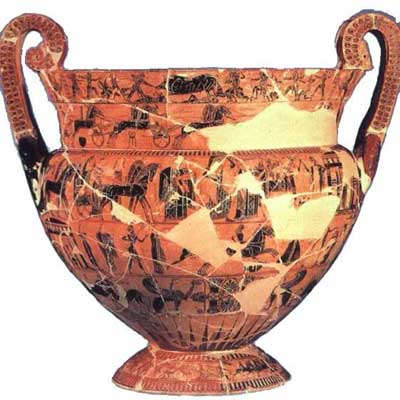
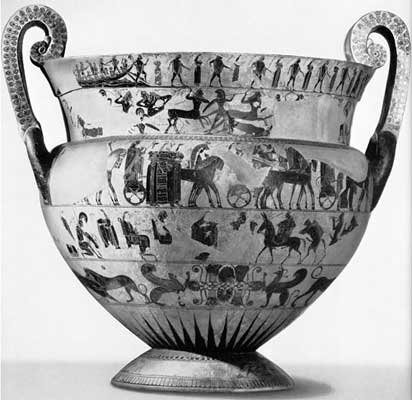
The François volute krater, potted by Ergotimos, painted by Kleitias, archaic ancient Greek Art, ca. 570 BC, Museo Archeologico, Florence. The main subject depicted on the François Vase is the wedding of Peleus and Thetis. Additional views and details: The Calydonian boar hunt and the chariot race for Patroclos, a fountain house, other side, arriving boat with Athenians and dancers, centauromachy, return of Hephaistos to Olympus, handle with Artemis, Achilles and Ajax

Phaidimos jumping over board of a triakonter ship, another swims to the beach.
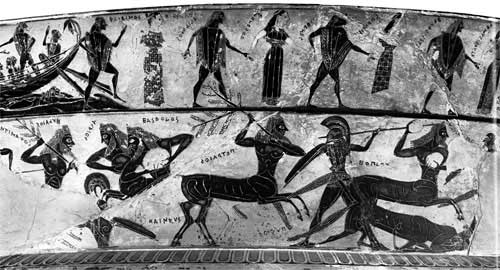
Top Row: Crane Dance (Geranos) of Theseus and the Athenian youths on their escape from Crete. According to Plutarch, Theseus after having killed the Minotaur in the Labyrinth of Knossos, on his way back to Athens, he stopped at Delos. There, he offered a sacrifice to the goddess Aphrodite and he danced around the altar. This dance included serpentine movements, imitating the movements of Theseus inside the Labyrinth. The dance is mentioned by Homer in the Iliad. Some experts say that the place of the dance shown here was on Crete and not Delos.
Figures shown: Phaidimos, Hippodameia, Daduchos (Daidochos), Menestho, Eurysthenes, Koronis, Euxistratos ( Heuxsistratos), Damasistrate, Antiochos, Asteria, Hermippos (Hernipo), Lysidike, Prokritos, and Eriboia (Epihoia)
Bottow Row: Battle between Lapiths and Centaurs. On the left 3 centaurs, Hylaios, Agrios and Hasbolos against the warrior Kaineus. In the middle the centaur Petraios against the Lapith Hoplon. On the right side the centaur Melanchites fighting with rocks against a Lapith, while another centaur on the groud probably dead.

Left Apollo with his hand raised approaches a fountainhouse, a Trojan yong boy places a hydria under a spout, Rhodia, Thetis (mother of Achilles) and Hermes and the back of Athena
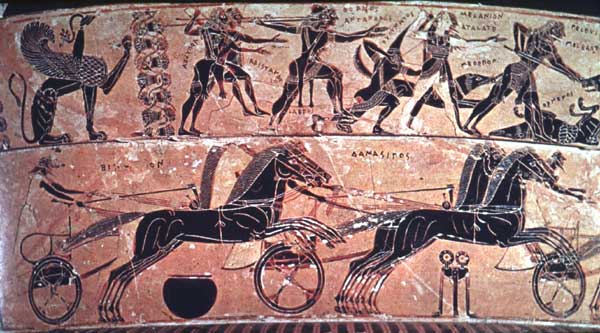
Top Row: Harpaleas and Aristandros, Thorax and Antadros with a spear, Euthymachos the archer, Atalanta and Peleus against the Calydonian Boar (part of his head only shown)
Bottom Row: Chariot race in the funeral games for Patroklos. In the center we can read clear the name of Damasippos (a brother in law of Odysseus)

Top Row: The hunt for the Calydonian Boar, 19 hunters and their dogs, on the right side the Dioskouroi Castor and Polydeukes, Akastos and his brother-in-law Admetos.
Bottom Row: Chariot race in the funeral games for Patroklos. Damasippos , Diomedes and Automedon
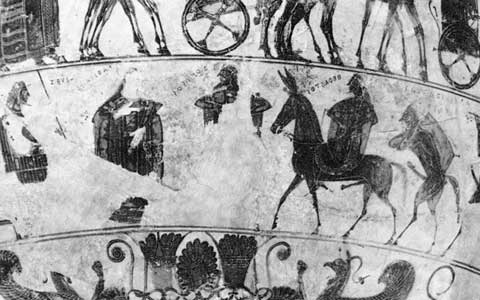
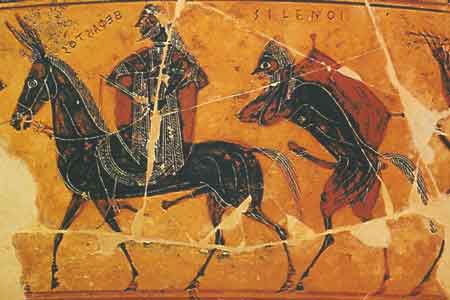
Hephaistos' trimphant return to Olymp, riding on a donkey and accompanied by silenoi or satyrs, half man, half goat creatures. Here one shown carrying a wineskin on his back. Note the written labels, early Greek could be written left to right or right to left. When Hephaistos was banished from the Olymp after some problems with Hera he was so angry that he sent to his mother Hera a golden throne, which however trapped her as soon as she sat in it. Only when Dionysos made him drunk he accepted to release Hera. As a gift he was allowed to marry Aphrodite and to return to the Olymp.
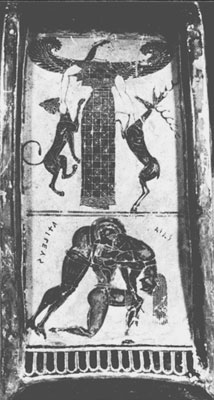
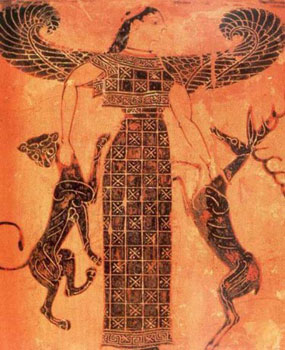
On one handle of the Volute Krater: Ajax carrying the dead Achilles, and Artemis as the Mistress of Beasts (Potnia Theron).
Pausanias abour another image of Artemis: On what account Artemis has wings on her shoulders I do not know; in her right hand she grips a leopard, in her left a lion.
I begin here with a vase of Attic manufacture, decorated, as an inscription on it shows, by Clitias, but commonly called from its finder the Francois vase. It may be assigned to the first half of the sixth century, and probably to somewhere near the beginning of that period. It is an early specimen of the class of black-figured vases, as they are called. The propriety of the name is obvious from the illustration. The objects represented were painted in black varnish upon the reddish clay, and the vase was then fired. Subsequently anatomical details, patterns of garments, and so on were indicated by means of lines cut through the varnish with a sharp instrument. Moreover, the exposed parts of the female figures--faces, hands, arms, and feet--were covered with white paint, this being the regular method in the black-figured style of distinguishing the flesh of female from that of male figures.
The decoration of the Francois vase is arranged in horizontal bands or zones. The subjects are almost wholly legendary and the vase is therefore a perfect mine of information for the student of Greek mythology. Our present interest, however, is rather in the character of the drawing. This may be better judged from Fig. 189, which is taken from the zone encircling the middle of the vase. The subject is the wedding of the mortal, Peleus, to the sea-goddess, Thetis, the wedding whose issue was Achilles, the great hero of the Iliad. To this ceremony came gods and goddesses and other supernatural beings. Our illustration shows Dionysus (Bacchus), god of wine, with a wine-jar on his shoulder and what is meant for a vine-branch above him. Behind him walk three female figures, who are the personified Seasons. Last comes a group consisting of two Muses and a four-horse chariot bearing Zeus, the chief of the gods, and Hera, his wife. The principle of isocephaly is observed on the vase as in a frieze of relief-sculpture. The figures are almost all drawn in profile, though the body is often shown more nearly from the front, e.g., in the case of the Seasons, and the eyes are always drawn as in front view. Out of the great multitude of figures on the vase there are only four in which the artist has shown the full face. Two of these are intentionally ugly Gorgons on the handles; the two others come within the limits of our specimen illustration. If Dionysus here appears almost like a caricature, that is only because the decorator is so little accustomed to drawing the face in front view. There are other interesting analogies between the designs on the vase and contemporary reliefs. For example, the bodies, when not disguised by garments, show an unnatural smallness at the waist, the feet of walking figures are planted flat on the ground, and there are cases in which the body and neck are so twisted that the face is turned in exactly the opposite direction to the feet. On the whole, Clitias shows rather more skill than a contemporary sculptor, probably because of the two arts that of the vase-painter had been the longer cultivated. F. B. Tarbell A History Of Greek Art
For more images, details and informations see: The Francois Vase (from Perseus)
| Ancient Greece
Science, Technology , Medicine , Warfare, , Biographies , Life , Cities/Places/Maps , Arts , Literature , Philosophy ,Olympics, Mythology , History , Images Medieval Greece / Byzantine Empire Science, Technology, Arts, , Warfare , Literature, Biographies, Icons, History Modern Greece Cities, Islands, Regions, Fauna/Flora ,Biographies , History , Warfare, Science/Technology, Literature, Music , Arts , Film/Actors , Sport , Fashion --- |

